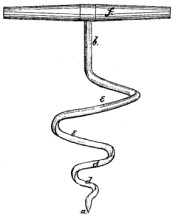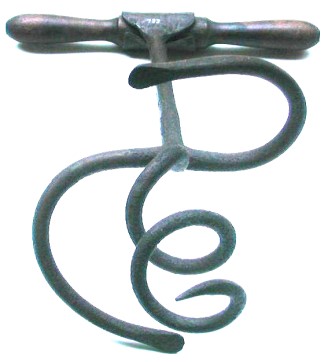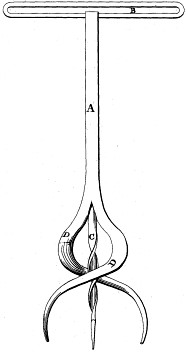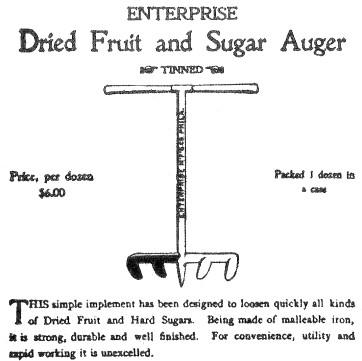 |
 The Virtual Corkscrew Museum's Weekly Newspaper |
 |
 |
 The Virtual Corkscrew Museum's Weekly Newspaper |
 |
|
Sunday, September 2, 2007 |
Number 476 |
Food Tools - Part 3
Fruit Lifters / Corkscrew Copycats? by Bob Roger

1870 - Wanted: A tool that can be pushed down, twisted, and pulled to remove a barrier to a container's contents. You say the corkscrew has already been invented? Hmmm.
Dried apples, dates, figs, apricots, peaches and many other varieties of fruits, sugar, and meats including pork and fish (in brine or dried) were packed into wooden barrels, and the contents were tightly compacted when the barrel head was pressed into position with a large screw-driven one-sided vise. Then the barrels were shipped via sea, rail, and wagon to the local mercantile, where the heads were removed and the contents offered for sale. The shipping of dried fruits in barrels had ended by 1900, although sugar continued to come in barrels for a short time after that (Reference: "Fruit Lifters", Laurence A. Johnson, The Chronicle of the Early American Industries Association, March 1957).
What you never saw in any "Western" movie was how the grocer got the tightly-packed contents out of the barrel. What he did was pick up his trusty fruit auger, turn it into the center of the mass a little way, and pull it out - just like pulling a cork out of a bottle with a corkscrew. In fact, most of these implements resemble cork pullers but are somewhat larger. With a small core removed, the sides of the hole could be loosened by pushing them into the space vacated by the core. Other designs just loosened the contents without pulling a core out.
Fruit lifter, dried fruit loosener, sugar devil, fruit auger - all of these names were used by patentees to describe food-handling implements that were prominent in mercantiles and general stores throughout the Victorian era, but which became obsolete around 1900. Strangely, they are also missing from many museums and implement collections.
The Patents
There were at least eleven U. S. patents for these tools, spanning about 25 years, and all but two of the patentees were from the mid-West.
Raymond Patent
Ragan Patent
Schmeltzer Patent
The first patent was number 112,959 issued on March 21, 1871 to Ennis A. Raymond of Waterloo, Iowa. His lifter was a helix with gradually increasing spiral diameter from point to top. To make his lifter he starts with about a five foot half-inch rod and bends it into a 9" long spiral with a four inch diameter at the basis.
The next patent was number 137,622 issued on April 8, 1873 to Cornelius Ragan of Waterloo, Iowa. He used a pointed 3/8 inch square bar to form his helix with his spiral diameter changing from 3 1/2 inches at the tip to 3 inches at the shank. His overall length was 18-20 inches.
Patent number 144,147 was issued on October 28, 1873 to John F. Schmeltzer and Joseph M. Roberts of Winona, Minnesota for a double-helix lifter. They also had their spiral diameter gradually change, being greatest at the tip.
Holman Patent

White Patent
Patton Patent
Patent number 144,542 was issued on November 11, 1873 to Harry W. Holman of Waterloo, Iowa for a lifter without a helix. He has a spear with pivoted wings at the tip. When pushed into the barrel the wings fold into the body of the spear, but when it is pulled up the wings pivot out, grabbing and loosening the contents. Notice the similarity of Holman's design to that of the cork pullers of Alexander (1860), Wyckoff (1861), and Williamson (1868) shown at the end of this article.
Patent number 166,171 was issued on July 27, 1875 to Henry J. White of Green Bay, Wisconsin. He has a central guide-rod and one or more spiral prongs. His handle may be either wooden or metallic. His drawing illustrates a twisted guide-rod but the patent description is silent on that matter. White assigned his patent to James V. Hiddleson of Chicago, Illinois. An advertisement in The American Grocer, November 10, 1881 illustrated White's lifter with the correct patent date and labeled as HIDDLESON's DRIED FRUIT AUGER. Its guide-rod is straight, and S. W. Sheldon of 93 Reade Street, NY is listed as the sole agent for it. So apparently White sold the patent to Hiddleson who manufactured it and contracted Sheldon to market it.
Next was patent number 172,278 issued on January 18, 1876 to Henry F. Patton of Appleton, Wisconsin. He assigned one-half to Albert S. Dean of Eau Claire, Wisconsin. His design consists of a pointed guide-rod that supports a bracket. Pivoted to the bracket is a two-pronged curved claw. The claw is placed in alignment with the guide-rod and the ensemble is pushed into the fruit near the edge of the barrel. The claw handle is then raised, swinging the claw through the fruit and loosening it.
McCormick Patent
Chesbro Patent
Patent number 177,863 was issued on May 23, 1876 to William McCormick of Blair, Nebraska. His concern was that existing lifters become clogged, and the design of his "flattened" double helix provided a more open 'core' between the arms and fewer turns than did Schmeltzer & Roberts.
Patent number 252,738 was issued on January 24, 1882 to Ernest P. Chesbro of Willimantic, CT for his device for breaking up sugar, salt, etc. It is pressed into the food while twisting, breaking it up so that it can be removed. Although his device has four arms of teeth and the teeth point straight down, it is quite similar to the two-armed ENTERPRISE Dried Fruit and Sugar Auger that has its teeth at an angle. The ENTERPRISE auger was advertised in the 1899 catalog of The Enterprise Manufacturing Company of Philadelphia, PA. That advertisement is illustrated below, and the auger in the illustration is marked ENTERPRISE M'F'G CO PHILA.

1899 Enterprise Catalog Advertisement
Coles Patent
Patent number 352,736 was issued on November 16, 1886 to John E. Coles of New York City. Coles refers to a previous patent of similar design but doesn't name it. Probably he is referring to White's patent. However, Coles' design is slightly different, having a larger diameter of twist for two or more turns in the center guide-rod and forming blades at the tips of the two coiled arms. He also places the tip of one arm lower than the other so that it engages the fruit first. Each arm then "shaves" layers off the fruit or sugar, much like a double-bladed twist auger cuts a hole in wood.
Elliott Patent
Swartz Patent
Patent number 365,247 was issued on June 21, 1887 to William P. Elliott of Shelbyville, Indiana. His guide-rod has a screw-point and twisted shaft, like a carpenter's wood bit but having sharp longitudinal edges instead of a cutting blade behind the screw-point as in the bit. He then fastens a wing to the shaft. The wing is shaped horizontally like a shallow "S", and in the vertical plane the top edge of the wing is approximately semicircular.
Design patent number D 31,896 was issued on November 28, 1899 to Francis Marion Swartz of Newark, Ohio. His design has a circular head and four downward-projecting tapered teeth arranged around a center guide-rod.
Variants of the Ragan & Schmeltzer patents
Pictured above are two forged examples of patent variants. The small unmarked double-helix on the left is a variant of Schmeltzer & Roberts 1873 patent (it was probably made earlier) and is well-sized for apricots and dates. It is 8 inches ling overall and the diameter of the prongs' sweep at the tip is 1 1/2 inches. That diameter reduces toward the handle, as the patent requires.
The unmarked single-helix lifter on the right is made of 3/8 inch round stock and has a coil diameter of 3 inches at the tip, reducing in size toward the handle. Overall length is 15 1/2 inches. This appears to be a variant of Ragan's 1873 patent, although Ragan used a 3/8 inch rod of square cross-section.
White's pre-patent (lower left) & White/Hiddleson
Above are two examples of White's 1875 patent. The example at the lower left with the twisted guide-rod appears to be a pre-patent example of White's patent, having the guide-rod as illustrated in the patent drawing but broader, more abbreviated arms. Each arm is marked PAT AP'D FOR. The overall length is 12 1/2 inches and it is 4 3/4 inches between the tips of the arms.
The example at the upper right is marked 'PATD JULY 27 75' and is the version of White's patent that was manufactured by Hiddleson and marketed by Sheldon. The tip of the guide-rod was bent by accident on this example. It should be straight to the point. The overall length is 16 1/4 inches and it is 4 1/2 inches between the tips of the arms. This version is the most common of all lifters and normally sells for $125 - $175.
Two views of McCormick's lifter
McCormick's 1876 patent marked PATD MAY 23 1876. The overall length is 14 3/4 inches and the arms are 6 inches apart.
Marked example of Coles' lifter
The photo above shows the business end of a Coles' lifter marked PAT NOV 16 86. It is 14 3/4 inches long and 8 inches between the tips of the arms. One arm extends 1/4 inch longer than the other, as stated in the patent. This is the second most common lifter, although not nearly as common as the White/Hiddleson lifter.
Coles' lifter (top) and an unmarked variant
Above is an example of Cole's lifter along with a rare unmarked variant that is identical except that the guide-rod is straight rather than a helix as called for in the patent.
If these tools were "necessary equipment" in every general store during the Victorian era, where are they today? That is a very good question. I have been looking for them for at least 25 years, and Table 1 gives the approximate number of times I have seen each design as an existing example, either physically or in photographs. The table below lists the designs in the same order as they were discussed in the patents above. As noted from the entries in the table, lifters other than White/Hiddleson and Coles are extremely rare
Patent / Design Marked Example Unmarked Example Unmarked Variant Raymond 0 0 0 Ragan 0 0 1 Schmeltzer & Roberts 0 0 1 Holman 0 0 0 White 1 0 0 White/Hiddleson 50+ ?* 0 Patton 0 0 0 McCormick 3 0 0 Chesbro 0 0 0 Enterprise 0 0 0 Coles 8-12 0 1 Elliott 0 0 0 Swartz 0 0 0 *Not all examples seen were examined closely for marked vs unmarked
Alexander Patent
Wyckoff Patent
Williamson Patent
Notice the similarity of Holman's design to that of the cork pullers of Charles Alexander (No. 29,539 issued August 7, 1860), William Wyckoff (No. 32,394 issued May 21, 1861), and David Williamson (No. 74,966 issued February 25, 1868) shown in Figure 3.
Editor's Note: Bob Roger is a collector of corkscrews and a wide variety of tools. He is the author of A Guide to Gimlets published in 2003 and Patented Ice Reducing Tools: An Identification Guide for Hand-Held Picks, Chippers, Crushers, and Shaves published in 2007. Anyone wishing to acquire the books or a marked McCormick's Patent Fruit Lifter should contact Bob Roger.
Next Week: Quirls and Potato Follow-up
|
©2007 Don Bull, Editor |